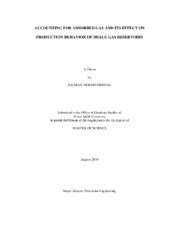| dc.description.abstract | Shale gas reservoirs have become a major source of energy in recent years.
Developments in hydraulic fracturing technology have made these reservoirs more
accessible and productive. Apart from other dissimilarities from conventional gas
reservoirs, one major difference is that a considerable amount of gas produced from
these reservoirs comes from desorption. Ignoring a major component of production, such
as desorption, could result in significant errors in analysis of these wells. Therefore it is
important to understand the adsorption phenomenon and to include its effect in order to
avoid erroneous analysis.
The objective of this work was to imbed the adsorbed gas in the techniques used
previously for the analysis of tight gas reservoirs. Most of the desorption from shale gas
reservoirs takes place in later time when there is considerable depletion of free gas and
the well is undergoing boundary dominated flow (BDF). For that matter BDF methods,
to estimate original gas in place (OGIP), that are presented in previous literature are
reviewed to include adsorbed gas in them. More over end of the transient time data can also be used to estimate OGIP. Kings modified z* and Bumb and McKee’s adsorption
compressibility factor for adsorbed gas are used in this work to include adsorption in the
BDF and end of transient time methods.
Employing a mass balance, including adsorbed gas, and the productivity index
equation for BDF, a procedure is presented to analyze the decline trend when adsorbed
gas is included. This procedure was programmed in EXCEL VBA named as shale gas
PSS with adsorption (SGPA). SGPA is used for field data analysis to show the
contribution of adsorbed gas during the life of the well and to apply the BDF methods to
estimate OGIP with and without adsorbed gas. The estimated OGIP’s were than used to
forecast future performance of wells with and without adsorption.
OGIP estimation methods when applied on field data from selected wells showed
that inclusion of adsorbed gas resulted in approximately 30 percent increase in OGIP estimates
and 17 percent decrease in recovery factor (RF) estimates. This work also demonstrates that
including adsorbed gas results in approximately 5percent less stimulated reservoir volume
estimate. | en |


